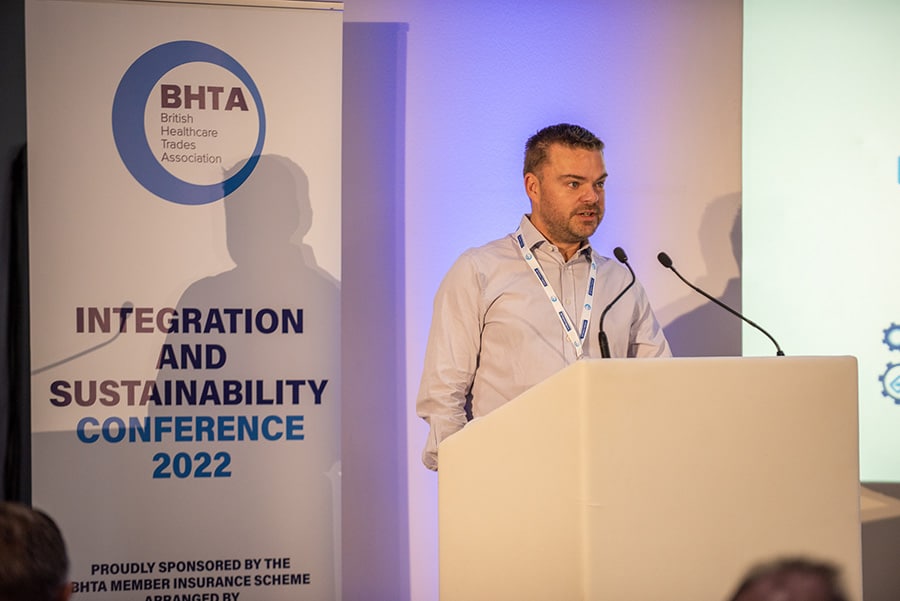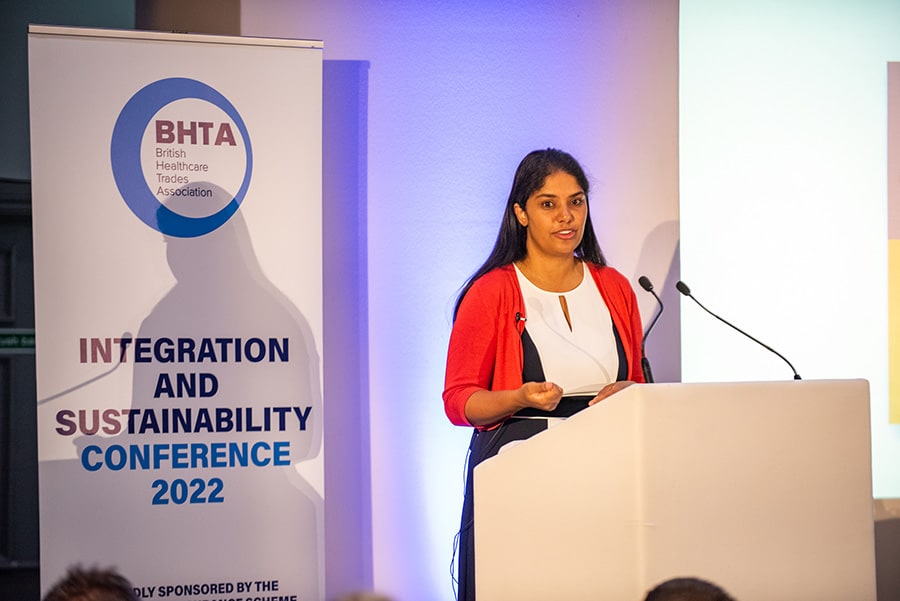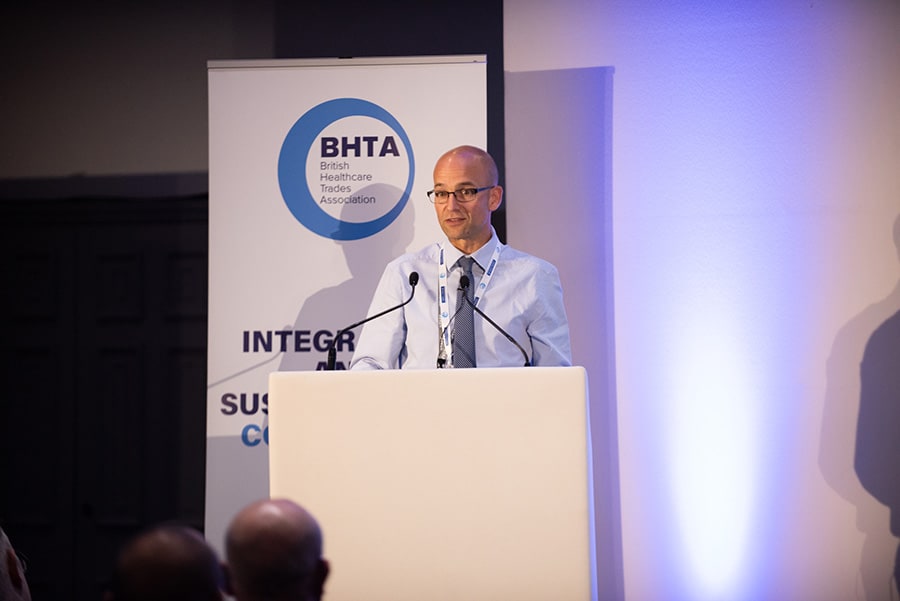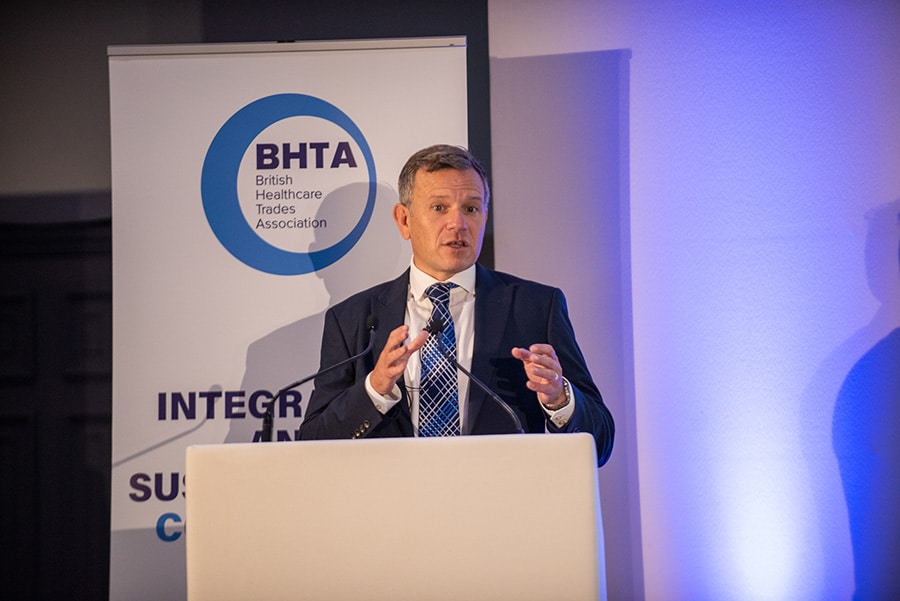Engaging conference explores assistive tech innovation, procurement improvements, and NHS net zero

Last month, healthcare and assistive technology professionals attended an esteemed conference that saw senior NHS and government figures discuss two of the most pressing topics affecting healthcare today: integration and sustainability.
Hearing from those responsible for setting healthcare policy, BHTA Integration and Sustainability Conference 2022 attendees gained in-depth, specific, and invaluable insights into the changing and complex landscape of integration and sustainability.
Working towards an NHS net zero by 2045, what the new NHS Central Commercial Function (CCF) is and how it impacts assistive technology suppliers, how procurement is changing to be more value-focused, communicating sustainability efforts, and what an innovative assistive technology product is are just some of the topics that were explored at the inaugural British Healthcare Trades Association (BHTA) Conference.
The conference took place on 22 September at The Tower Hotel in London, set to the picturesque backdrop of London’s iconic Tower Bridge.
Both BHTA member companies and non-member firms were invited to hear thought-provoking presentations on embedding integration and sustainability initiatives. From supplier-specific advice on how much weighting is placed on local manufacturing when procuring through to sharing the success of a reusable walking aid NHS pilot, attendees left the conference with a tonne of helpful information and insights.
The morning sessions were delivered by David Stockdale, Chief Executive Officer for the British Healthcare Trades Association; Preeya Bailie, Director of Procurement Transformation and Commercial Delivery for NHS England & Improvement; Andrew New, Chief Executive Officer for NHS Supply Chain; and Andy Windsor, Commercial Executive Director for NHS Supply Chain.
Below, AT Today discusses the fascinating conference content from the morning presentations as well as the stimulating panel discussion.
Opening address

David Stockdale, BHTA CEO, kicked off the BHTA Integration and Sustainability Conference 2022 with an overview of the BHTA, what it does for its members, and future plans for the association.
“I’m very excited to be introducing a conference agenda today that’s incredibly relevant, and I’m really delighted that we have such a high-level cabaret of speakers,” David opened. “In terms of the BHTA, we’re here to champion our members, protect consumers, shape policy, drive standards, and raise the profile of the industry.”
He mentioned that with the constant changing landscape facing UK healthcare firms, the BHTA exists to ensure that its members’ concerns are heard by the UK Government. In particular, David referenced energy prices, supply chain disruption, procurement concerns, and the ongoing impact of COVID as key challenges that BHTA members are facing.
David added: “We’re in an incredibly challenging period at the moment. Myself and our Head of Policy and Compliance William Lee will look at how we represent you to the MHRA and make sure that decisionmakers are hearing your concerns of business as the regulatory framework transforms and adapts to the challenges we now face. We’ve got a new government now, so how we interact with that will be incredibly important.”
Net zero, NHS Centralised Commercial Function, and changing procurement

After his opening address, David welcomed Preeya Bailie, Director of Procurement Transformation and Commercial Delivery for NHS England & Improvement, to the stage for a presentation about NHS’ sustainability targets and improvements to procurement.
Preeya’s team is responsible for all national procurements. She is also responsible for NHS net zero and ensuring that the entire NHS supply chain is net zero by 2045.
A large focus of Preeya’s talk was around bringing the procurement community together for better and more consistent collaborative working. This involves creating a centrally driven NHS commercial strategy that binds the procurement community, drives collaboration across NHS commercial teams, and links with NHS’ collective buying power.
To this end, the NHS has created the NHS Central Commercial Function (CCF). The CCF is designed to make it easier for end-users to purchase the products and services they need. It revolves around driving commercial value across the NHS.
“This is about the foundations and principles of how we start to come together, across ICBs, as a central community to start to think about what things we should buy nationally together, and, if we are going to buy locally, there’s more consistency,” she explained.
There are seven core offerings across the CCF: commercial best practice; people and community; governance, assurance, and process; technology and data; commercial strategies; sustainability and innovation; and sourcing and management.
Across these seven areas, there are some common themes. These include ensuring commercial best practice, driving better value across the NHS, national vs local buying, visibility around where the NHS is spending money, and improving supplier relationships.
Another key part of Preeya’s talk was around the NHS’ target of achieving net zero by 2045.
She said: “Why a net zero health service? You’ve probably heard a few times from my team that climate emergency is a health emergency. We’ve set the target to achieve net zero by 2045. With an organisation of that size and complexity, where do you start? My team has focused on three areas.”
The first area is procurement and influencing everything that is purchased into the NHS in terms of being sustainable.
Preeya said that the second area is about changing NHS demand to make it easier for patients and staff to do the “right thing”. This is about raising the expectations of NHS staff, so that they ask for a more sustainable and environmentally friendly product.
The final area is suppliers, including assistive technology suppliers. This is about forging better relationships with suppliers to meet the net zero deadline.
She also gave a clear message to suppliers about another upcoming deadline: “By 2030, the NHS will no longer purchase from suppliers that do not meet or exceed our commitment to net zero. That’s not saying be net zero by 2030, but it is about engaging with us around the targets that we’re setting around reducing emissions.”
Currently, the NHS has a 10 percent weighting around net zero and social value on all of its procurements, Preeya highlighted. This means that assistive technology suppliers who start focusing on net zero early could have a better chance at winning NHS contracts.
For 2023-2024, for all Procurement Policy Notice 06/20 contracts above £5 million, the NHS will require suppliers to publish a carbon reduction plan for their scopes 1 and 2 emissions as a minimum, she added.
Suppliers were also encouraged to share their carbon emission reduction plans with the NHS ahead of various targets. They were urged to take a proactive approach to sharing this information with the NHS rather than waiting to be asked.
Tender consistency and better teamworking

Next to the stage was Andrew New, Chief Executive Officer for NHS Supply Chain, who underlined that suppliers will start to see more consistency across tenders and opportunities.
He explained: “There are great questions around social value and what does that mean. At the moment, you’ll get 11 different versions of what social value means. If you work with five or six of the different category teams, they will always answer in a different way. That’s what they’ve been asked to do. They’ve been asked autonomously for your own portfolio of products to drive the best outcome. We’ve done that bit. Now standardisation will be better for the NHS as a whole.
“All the different players in the system are starting to line up behind common messages, common ways of working, and make sure they have a simpler, robust healthcare system for the future.”
Building on these ambitions of a more standardised NHS, the NHS Supply Chain has set targets for internal teams and has six areas of focus.
The first area says that the organisation has to become a partner, and not a supplier, to NHS trusts and ICSs. This means working more collaboratively with the NHS to ensure everyone is working towards a common goal: what is right for the NHS.
The second area is about improving ways of working and making sure that the NHS’ foundations are strong to encourage future growth.
The third area is about category experts.
Strength and resilience are the fourth area of focus. This focuses on making sure NHS Supply Chain is more agile to deal with unprecedented and changing challenges. To achieve this, it will include engaging with suppliers and ensuring that people are fulfilling their obligations.
The next area is data strategy. There is a desire within the NHS to have a federated data platform for greater structure. This includes NHS Supply Chain feeding data into the system that explains how consumption works, and which hospitals are consuming which elements, in which places, and at what times.
The sixth and final area is around creating longer-term NHS plans.
Andrew said: “Historically, we’ve always been very focused on ‘deliver the plan for today’, and then next year we come out with another plan for next year.
“What we’ve done across the business is said ‘what we are going to deliver over the next three-five years looks like this’. We need to make sure we’re committing about a sixth of our time into making sure that we are the right organisation in three years’ time, not just the right organisation today.”
Proactive data sharing and NHS resilience efforts

Andy Windsor, Commercial Executive Director for NHS Supply Chain, was next to talk at the BHTA Conference 2022.
Again, a big theme in Andy’s talk was around sustainability and reducing carbon footprints. He reiterated the point from earlier presentations that suppliers should be proactive in sharing the work they are doing around reducing carbon emissions with NHS Supply Chain.
He stated: “It is the responsibility of our suppliers to tell us what they’re doing. Don’t wait to be asked. I believe that these objectives [carbon emission] are achievable because you’re doing this already.”
As the sector moves into the traditional challenging winter period, the NHS is critically focusing on resilience and continuity of supply – a goal that has been thrust into the limelight post-COVID. NHS Supply Chain has done a number of initiatives to support NHS resilience.
Andy explained: “We’ve increased our stock holdings in those critical items; we’ve looked to improve our supplier inbound performance; and we’re looking to align on what are the most optimum supply channels, whether that be through direct routes or through ourselves.
“We have a number of sole suppliers. That’s okay. Innovation oftentimes puts us in that position, and the NHS and the patients that we serve recognise our products for that. However, that in itself can provide challenges from a resilience perspective, so we are continually challenging ourselves to come up with alternatives, and we are doing that across our top 8,000 products.”
NHS Supply Chain is also doing work on future supply chain mapping to support the resilience objectives. This is a prerequisite for suppliers, Andy confirmed.
In addition, the organisation is doing work around its strategic supplier relationship management approach to improve the way it works with suppliers. A new team and operational model have been set up to create a standard approach and framework that enables NHS Supply Chain to articulate what it does, how it does it, and why it does it.
“We want to become easier to work with, we want to create opportunities with that one point of contact, and the one view of the supplier, and we’re going to drive accountability for our and your account structures,” added Andy.
He mentioned that there is effort being made to reduce complexity across NHS Supply Chain.
“What we do should be a fairly simple transaction of buying something, storing something, and delivering something to a customer who is fairly consistent in terms of what they need because they’re operating to a fairly standard way of working. We are working to streamline what we do and how we do it. Our data management strategy that Andrew talked about will be critical to the delivery of that.”
Assistive technology services need to meet people’s needs

One of the most interesting questions from the morning panel discussion came from Kate Sheehan, Occupational Therapist and Director of the OT Service.
Kate gave the example that, currently, in NHS wheelchair services, there is no scope for flexibility in terms of providing patients a wheelchair that will meet their needs. She argued that patients are given a set wheelchair, and that is it. The wheelchair often does not help the user participate at work or for leisure.
From a sustainability perspective, Kate said that giving a person a wheelchair that truly meets their needs is better for the environment – the wheelchair will last for three-five years, not just one year. She added that getting wheelchair spare parts quickly and efficiently means that the device can be repaired and reused, if necessary.
She then asked the panel a tricky question: “How do we do that in a service where it’s so based on cost and not on individual need? We need to give back purpose and meaning to people’s lives, so they can go on and be sustainable themselves as well.”
Preeya explained that the NHS has been looking into reusable walking aids, engaging with the Royal College of Nurses and allied health professionals. She mentioned that when the NHS initially had discussions with suppliers, many said that walking aids are single-use and that is all. However, the NHS wanted to get past this.
Now, the NHS is moving towards reusable walking aids. This has been supported by suppliers and NHS trusts, Preeya added.
She said that while the NHS has not looked at wheelchairs specifically yet, she can take this back to her procurement team as an area to look into. She told Kate that wheelchairs would fall under the category ‘aids and adaptations’ – a space that the NHS is going to explore.
Andrew New responded: “For me, this is the difference between buying stuff and doing category management properly. If you’re going to develop a category strategy, you start by following your scope and you assess need. The solution that you finish with should address the need.
“In this case, the need isn’t ‘we need a wheelchair that works in this way’, the need is ‘we need people back at work because that’s the thing that delivers the population health benefit’. If you can establish that need at the beginning of your process, when you’re assessing your options about how you go to market later, you’re assessing them against ‘will it fulfil that need or not?’ If it doesn’t, are you doing the right thing?”
Andy Windsor, interestingly, made a point that suppliers can create the problem of always providing the same products into the NHS.
He argued: “From a supplier perspective, and this comes from my own past experience, the tendency is to try and sell the products that we have today, rather than understanding the problem that we’re trying to solve.
“I think, as an industry, we need to work harder at understanding the problem we’re trying to solve and focusing around providing those solution, not pushing the products that we’ve always sold. That only leads to one outcome, which is everyone’s selling the same products, and we’ll just have to go to a competitive price situation. You can almost create the problem.”
What does innovation mean?
Another fantastic question came from the panel host, William Lee, Head of Policy and Compliance at the British Healthcare Trades Association. He asked Preeya, Andy Windsor, and Andrew New what does the NHS mean by the term “innovation”?
Andrew New was very clear in stating that iterations of the same product do not equate to being “innovative”.
He told the suppliers: “Please don’t come to me with a ‘you used to buy product 1234, I’m listing an ‘a’ at the end of it, painting it green, and tell you it’s now new and better’ because all you’re doing is taking the time away from the team that’s trying to work out what’s the real innovation we need to go after. Please don’t try to push the new version of the old thing.
“Actually, there’s an understanding that for breakthrough innovation that we’ve got capacity to deal with we will try to get that product through the system.”

